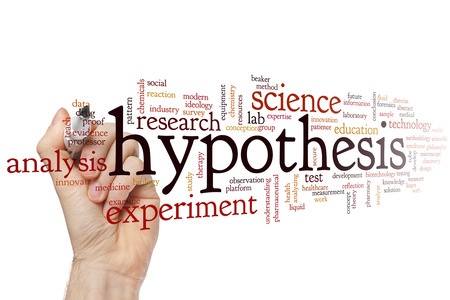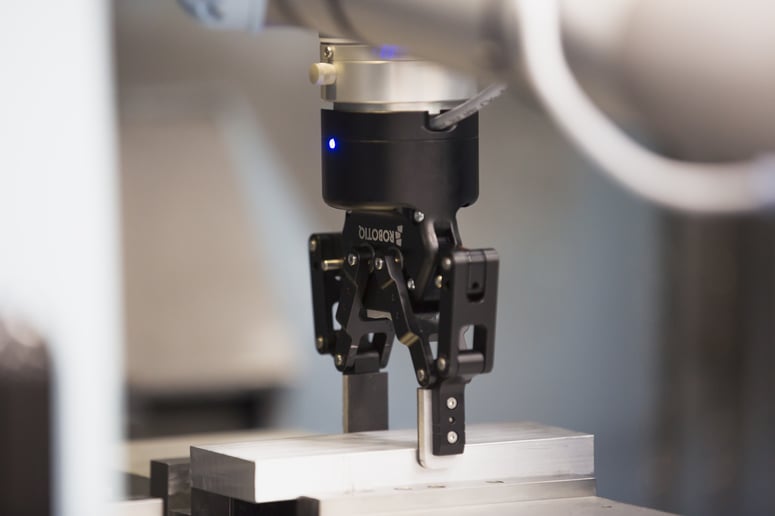This Single Statement Generates Great Robotic Research

You might not believe it but you can make your research experiments instantly more effective by taking the time to write down one single statement. It doesn't matter if you're an academic roboticist or working in corporate R&D, getting a grasp on this vital research skill can be enough to ensure publishable experiments or push your product development closer to the customer. Despite this, it's uncommon to find robotics researchers using the statement. What is this magical sentence???
…A hypothesis, of course. Writing a hypothesis is a key skill for experimental design.

But, before you dismiss the hypothesis as "a triviality" take a moment to ask yourself how often you actually write down the hypothesis for your robotic experiments? Do you take time to craft your hypothesis into a clear, testable, single statement before launching into an experiment? How many hypotheses have you seen stated in the robotic research papers you have read?
Unlike many other research fields (e.g. social sciences, medicine and natural sciences) we robotics researchers don't often make a big deal out of forming a hypothesis. Most learning material about hypotheses use examples from these other fields, which can seem irrelevant to robotics. Unfortunately, it is uncommon to see a hypothesis clearly stated within a robotics paper.
Does this mean that robotic research doesn't use hypotheses? No, it's just that our hypotheses are not stated explicitly.
However, it often means that researchers don't take the time to state their hypotheses clearly, even for themselves during their planning of an experiment. This can really damage their chances of conducting a good experiment. After all, how can your experiment be good without knowing what hypothesis you're testing?
Despite some discussion about whether hypotheses are vital in engineering, with good arguments on both sides of the debate, engineering fields like robotics do benefit greatly from hypotheses.
In this post, we look at some high quality robotics papers and show how their hypotheses (even when not stated explicitly) made them worthy of research paper awards.
The Hidden Hypotheses in Robotics R&D
If you are working in corporate Research and Development, you might wonder if you need to learn hypothesis writing skills.
Although the concept is usually used in reference to pure academic research, hypothesis writing is still very relevant to R&D work. In fact, I would even go so far as to say that a well formed hypothesis is even more important in robotics R&D than it is in pure research.
Academic journals and conferences might forgive a weak experimental design section if the methodology section of the research paper demonstrates something impressively novel. However, in industrial R&D you want to be able to say with certainty: "our new  developments are an improvement on the previous systems in these specific ways." To make such statements, you need to conduct tests/experiments which have been designed to prove very specific hypotheses.
developments are an improvement on the previous systems in these specific ways." To make such statements, you need to conduct tests/experiments which have been designed to prove very specific hypotheses.
As this great article about business hypotheses from Requirements Engineering Magazine explains: "projects need to broaden their scope and not only work on solutions but also commit to the discovery of the right problem."
To find the right problem that your product solves, you need to have good hypothesis writing skills.
What is a Hypothesis Anyway?
Simply put, a hypothesis is a statement which makes a prediction about something which is not proven. It is a kind of educated guess.
You need a hypothesis when you want to prove something through experimentation.
In biology, for example, the purpose of the whole research field is to make predictions about the state of the world and then do experiments to prove or disprove them. Therefore, a strong hypothesis in biology is an easy thing to spot. It might look something like:
"When the salt levels in the water fall, sea trout have a higher rate of mortality."
This is a simple, clear and testable hypothesis which is provable (or disprovable) by experiments.
Robotics is a little different from the natural sciences, because it is primarily an engineering field. The Engineering Process is different from the Scientific Method, because it doesn't usually make hypotheses and conduct experiments to prove them. Instead, it defines design criteria and then develops technologies which achieve those criteria.
Most of the research work in robotics is spent on developing new technologies and methodologies. However, even though the primary purpose of your research is not to prove a hypothesis, as it is in natural science research, you still need a hypothesis to conduct experiments which prove that your developments work as well as you claim they do.
Therefore, a typical robotics hypothesis might look something like:
"Our algorithm calculates the solution faster than a naive algorithm can calculate the same problem."
For robotics, a good hypothesis is most important for the experimental section of the paper, which is often neglected in lower quality research.
How to Write a Good Robotics Hypothesis
A good hypothesis will satisfy 10 characteristics:
- It predicts an outcome. It is not valid to write a hypothesis which says "Our robot works." You should apply your technology (to a setup, data-set, etc) and predict the outcome, even if you choose to omit your original prediction from the published paper.
- It is provable or disprovable. A statement that is unprovable is not a hypothesis, nor is a statement which is always true or false regardless of the results.
- It is simple.
- It is clear.
- It is testable. You can't say "our algorithm is more memory efficient than all other algorithms" because you could never test all other algorithms.
- It's relevant to a problem. Don't, for example, claim to have developed a low power robot and then design an experiment which tests the hypothesis "Our robot can complete this specific task in under 10 seconds" because this omits the key aspect of "low power robot" in your hypothesis and, thus, your experiment.
- It is specific. The following is not a hypothesis: "Our robot is better than our previous robot." What specific aspect of the robot is "better"? By how much is it an improvement over the previous model? How might you be able to demonstrate this?
- It is relevant to available techniques. For both academics and R&D engineers, two of the best ways to learn available experimental techniques is to read many research papers and also read industrial robot standards, which often include testing procedures which are useful when designing experiments.
- It must invite many more questions and avenues of research. One sign of a good experiment is that it causes you to think of many new hypotheses for future experiments and future robotic developments.
- It must be internally consistent. There should be no conflicts or contradictions within the hypothesis itself.
One way of structuring a hypothesis is to start off by writing it in the form:
"If ___[I do this]___ then ___ [this] ___ will happen."
This might commonly be phrased in robotics as something like:
"If I apply this technique to this particular robot then the robot will be able to achieve this specific task with a particular level of performance."
Once you've written a draft hypothesis, it's important to take a step back and ask yourself if the hypothesis has a "purpose".
As Engineering Design researcher Erik K. Antossen says: "it is not valid to simply hypothesize that a device to perform a certain function can be designed and fabricated. This "hypothesis" naturally begs the question "Why?" and as such is not a legitimate focus for research."
There must be a purpose for your research experiment, otherwise you will be in danger that other people (including reviewers, customers or shareholders) will say "So What?" This might cause them to reject your long developed new technology or methodology, even though it's actually the experimental design which was at fault, not the technology itself.
Do not stick with your first hypothesis. Instead, try to rewrite it and improve it. Is there anything you could add which would make the experiment more impressive or more comprehensive? Changing a single statement is far easier than changing a whole experimental test setup. Any improvements you make to the hypothesis now will save you a lot of time later.
Some Good Examples of Hypotheses from Real Papers
In this section, I have taken three papers which were finalists for ICRA 2015 Paper Awards.
Their hypotheses are not stated explicitly, but I have done my best to understand their contributions and write a possible formulation of their experimental hypotheses in plain English. However, I cannot claim to understand all the mathematics and theoretical intricacies of the papers in depth. If you think that I've misread the hypothesis of any paper, please let me know in the comments and I'll happily update the post.
Example 1: Case study in non-prehensile manipulation: planning and orbital stabilization of one-directional rollings for the "Butterfly'' robot (Surov et al 2015)
The authors of this paper propose a methodology to tackle an already existing benchmarking task for manipulation, known as the Butterfly robot. This is a largely mathematical paper, so it uses the terms Theorem and Lemma, which are different from a hypothesis, because they are provable mathematically. As we've said, hypotheses are not proven yet, they are just educated guesses made before a proof. The main contribution of the work is a mathematical model.
One possible hypothesis for this paper's experiment is:
If we approach the Butterfly robot using our proposed motion control algorithm, then the resultant model is an accurate representation of real world dynamics.
Although it takes up a relatively small amount of the paper, their experiment proves this hypothesis by showing the results from a physical test with the algorithm.
You might think that the hypothesis could have ended “the resultant model is a more accurate representation of real world dynamics than previous formulations of the problem”. This may be true and authors do mention the advantages of their method over previous approaches. However, they don't perform any experiments which compare their method with previous approaches, so this would not be an accurate hypothesis for this paper's experimental section, though it could be a hypothesis for their research as a whole.
Example 2. Multi-Robot Grasp Planning for Sequential Assembly Operations (Dogar et al 2015)
In this paper, the authors use multiple mobile manipulators to construct a flat-packed chair with or without re-grasps (i.e. putting down the piece and picking it up in a different way).
The hypothesis can be more or less expressed like this:
Our algorithm calculates a good enough manipulation solution with few re-grasps faster than a naive algorithm can calculate the same problem optimally (i.e. with no re-grasps).
For the sake of demonstration, here is an example of what a less specific hypothesis might look like, one which does not define variables. It is completely unspecific as to what "quickly" means:
Our algorithm can calculate a solution quickly.
Another problem might arise if the hypothesis does not include testability. For example, this hypothesis would not be testable, because you could never test all of the other algorithms:
Our algorithm calculates a solution better than all of the other planning algorithms.
Example 3: Grasping without Squeezing: Shear Adhesion Gripper with Fibrillar Thin Film (Hawkes et al 2015)
This is what I personally think of as "a classic style robotics paper", where the authors propose a new robotic technology and demonstrate that it works well.
It presents a new type of gripper which, as the authors explain, does not use normal forces to pick up objects as most robotic grippers do. Instead, the gripper uses shear forces which are applied to the manipulated object via a flexible film.
I've adapted one possible hypothesis from a statement that the authors make in the conclusions section:
If a gripper uses shear adhesion forces then it will be a viable option for robotic grasping of objects with a large radius of curvature.
These examples have hopefully given you a starting point to extract the hypotheses from research papers you read. Use what you learn to improve your research experiments to get more publishable papers (if you're an academic) and get more developments to market (if you're in R&D).
How often do you take time to write out a hypothesis for your robotic experiments? Do you think hypotheses are as relevant in robotics as they are in other fields? What interesting hypotheses have you drawn from research papers you have read? Tell us in the comments below or join the discussion on LinkedIn, Twitter or Facebook.










Leave a comment